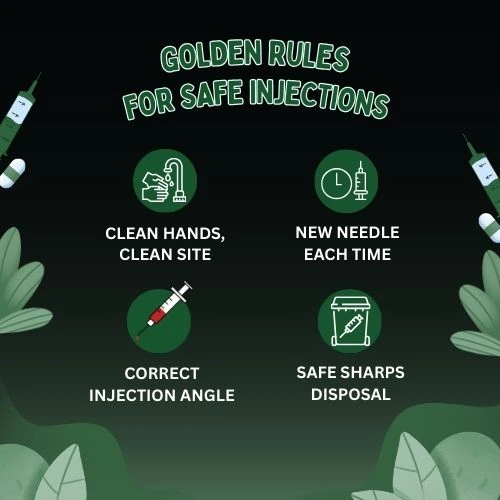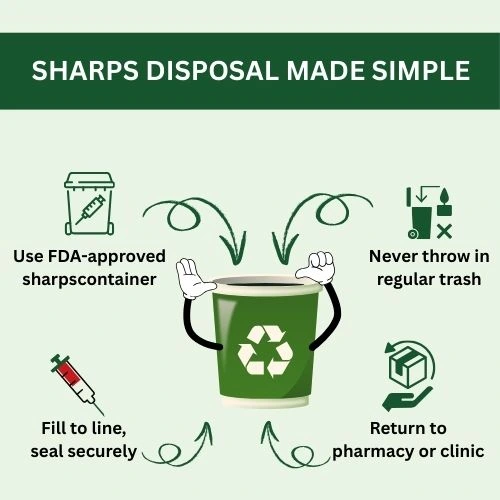Injections at home have become a common practise among many who are needed to administer the medications that diagnose their chronic diseases such as diabetes, hormone replacement therapies, or B vitamin deficiencies. Injections may be scary at onset, but the fear can be quelled through appropriate information and preparation, and become a painless yet well-controlled procedure eventually.
This home care guide will take you step-by-step through all you need to know about injection safety at home such as how, where, and why to administer a needle as well as safe sharps disposal, and why swabs work.

Why Injection Safety is Important
Either self administering an injection or administering with a loved one, safety should be paramount. Without the necessary skills in injection practises, there are infections, skin, and needlestick injuries, and even transmission of blood-borne diseases, in case of improper handling of the sharps. Knowing the fundamentals means not only that you are keeping yourself healthy but also that you will have confidence in home care.
Either self administering an injection or administering with a loved one, safety should be paramount. Without the necessary skills in injection practises, there are infections, skin, and needlestick injuries, and even transmission of blood-borne diseases, in case of improper handling of the sharps. Knowing the fundamentals means not only that you are keeping yourself healthy but also that you will have confidence in home care.
1. Selection of the Correct Needle and Syringe
Not every needle is identical. The injection type (intramuscular, subcutaneous, or intradermal) and the drug to be used determine the needle’s length and size.”
- Gauge: This tells the thickness of the needle. Thinner the needle, the greater the gauge.
- Length: Depending on where you will have the injection (such as an intramuscular injection will likely need a longer needle in comparison to subcutaneous shots).
- Syringe volume: This will depend on the amount of medication that will be required to give.
Always use proper-sized, clean, and sealed needles and syringes when injecting. It is not safe to reuse or give needles to someone or a loved one.
2. The First Line of Defence: swabs
Clean the injection site with alcohol swab before you inject. This cleans off bacteria and reduces likelihood of skin infections. Here’s how:
- Take a new alcohol swab in an unopened pack.
- Wipe in circular direction, toward the centre.
- And allow to dry (do not blow on it).
Clean the rubber stopper of the vial with an alcohol swab before drawing up the drug.
3. Correct Endroute Technique
It requires learning a proper technique. The following are simple general instructions to follow (however with medication variations may occur):
1. Wet and scrub your hands with soap.
2. Take your syringe and drug.
3. Clean and inject the site of choice.
4. Keep the syringe and hold like a dart and insert the needle fast at the proper angle:
- Subcutaneous: 45- 90 degrees
- Intramuscular: 90 degrees
5. Press slowly while pushing the plunger.
6. Remove a needle and put mild pressure using cotton ball or gauze.
This can be smoother with practise and supervision by healthcare provider.

4. Safe Sharps Disposal
Call blunt needles sharps waste, and never discard them in the trash, toilet, or sink. Not disposing of them in the correct manner can hurt someone and pose health hazards to other people.
- Put in a sharps container: This is a completely puncture-resistant container approved by the FDA to keep used needles and syringes in.
- Fill it up, cover the container and dispose of it according to the rules in your area (you can always ask guidance to your pharmacy or local health department).
- Never attempt to recap, bend or break needle.
If you don’t have a specific sharps container, use a hard plastic, tightly-lidded container (even a laundry detergent bottle) temporarily, as long as you clearly label it.
5. Storing and handling of medications
- Keep your drugs as the doctor orders (some need to be kept in the fridge).
- Look at the expiration and appearance prior to usage.
- Store other supplies where children and pets cannot reach.
- Injectable medication should not be frozen except when told to do so by a physician.
6. Know the Time to Seek Help
Though injections can be conveniently performed at home in most cases, consult a professional whenever you find that you are subjected to:
- Excessive redness, swelling or pain of where the shot was injected
- Allergic mechanisms (including a rash, itching, and respiratory difficulties)
- Bleeding and bruising not normal
- There is uncertainty of dose or method
It can also be supported by consulting a nurse or a doctor especially at the beginning to grow confidence and stay safe.
Final Thoughts
An injection at home should not be scary. Proper preparation, access to the right tools and a sense of hygiene will allow you to tend to your body safely in the comfort of your personal environment. You must respect the process-it is not just to take care of yourself, it is to take care of everyone in your proximity.
And keep in mind: Clean hands, clean site, new needle, safe disposal these are the golden rules of home injection safety. Be informed, be safe and ask when you are not sure.
Disclaimer: This guide is informational and not a substitute to medical advise. Always take guidance of your health practitioner.

Leave a Reply